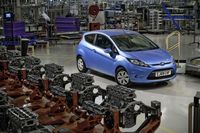Ford Dagenham at 80
DAGENHAM, UNITED KINGDOM - May 13, 2009: Ford Dagenham is celebrating 80 years of manufacturing as its engine production rate tops 1,000,000 units a year.
The 475-acre complex on the Thames, which majors in diesel engine design and manufacture, produced 1,050,000 units in 2008, ranging from 1.4-litre four-cylinder engines to 3.6-litre V8s for delivery to vehicle assembly plants across Europe.
Rising demand for diesel engines had pushed Dagenham output up by over 16 per cent on the previous year. Following £800 million of investment this decade, Ford Dagenham has the capacity to assemble 1.4 million engines a year.
Edsel Ford cuts the first turf
On May 17, 1929, company
founder Henry Ford's son, Edsel, was the first to dig into the low-lying
marsh which the company had bought five years earlier for £167,700. Around
20,000 piles had to be sunk 80 feet into the ground to support the engine
and car factory.
Today the site employs a total of 4,000 people in engine, stamping and transport operations. Ford engineers and production specialists at Dagenham are responsible for the development and assembly of diesel engines fitted to 28 different Ford, Jaguar, Land Rover and Peugeot CitroŽn models. Four-cylinder 1.4-, 1.6-, 1.8-, 2.0-, 2.2- and 2.4-litre units are produced alongside 2.7- and 3.0-litre V6 engines and a 3.6-litre V8.
Key roles for transport and stamping operations
Engines are
taken from the production lines by on-site transport operations for onward
delivery by road, rail and sea. Railway lines service the site, which
boasts a deep water jetty used to load and unload vessels travelling
between Ford plants. Dagenham's transport operations import and export
300,000 vehicles a year. They also handle the 15,000,000 stampings, such as
vehicle body panels, bonnets and bootlids, and 1,800,000 wheels produced by
Dagenham's stamping and tooling operations.
Dagenham plant manager Dave Parker said: "Ford Dagenham is ideally positioned to give quick and easy access to our markets which continue to sustain operations here after 80 years. Today we're at the centre of Ford's fuel efficiency drive as exemplified by the 76mpg diesel engine supplied for the new Ford Fiesta. Ford Dagenham has a rich manufacturing, economic and social heritage, which has provided the foundation for its competitive position today."
From AA truck to "Tiger" engine
Ford Dagenham took 28 months
to build, from Edsel Ford digging the first turf with a silver spade in May
1929 to its first vehicle, a Model AA truck, rolling off the production
line in October 1931. Special trains moved 2,000 Ford employees and their
families to their new Dagenham homes from Trafford Park, Manchester –
the company's first UK plant.
Both the Model AA and another pre-World War II star, the Model Y, are in Ford's Dagenham-based heritage collection and will be driven to celebrate its 80th landmark. The Ford Model Y was the lowest priced saloon ever made, with the Popular model introduced in 1935 being the first and only £100 car.
After the war Dagenham reverted to vehicle and engine production from the 4x4 trucks and gun carriers required by the military. Advanced Dagenham-built Ford Consul and Zephyr ranges were shown at the 1950 motor show, leading to the expansion of the plant by 50 per cent to accommodate resulting demand.
By 1966 the original riverside building was dedicated to engine manufacturing, covering a 1.1 to 2.4-litre range. Within 20 years Ford Dagenham had secured its position as the company's only dedicated diesel engine facility globally.
This was reinforced at the turn of the millennium when a second Ford Dagenham engine plant was commissioned, opened by Prime Minister Tony Blair in 2003. Called the Dagenham Diesel Centre, the £325 million investment includes the "Tiger" line making 1.6 engines for Ford's low CO2 ECOnetic range, which is enjoying increased demand as a result of vehicle scrappage schemes announced across Europe.



